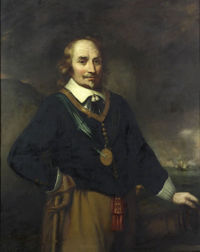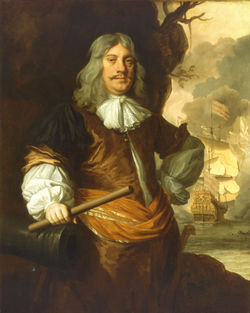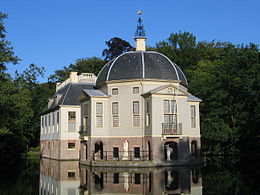- Maarten Tromp
-
Maarten Harpertszoon Tromp (23 April 1598 – 10 August 1653) was an officer and later admiral in the Dutch navy. His first name is also spelled as Maerten.
Contents
Early life
Born in Brill, Tromp was the first son of Harpert Maertensz, a naval officer who became captain of the Olifantstromp, from the name of which ship probably the family name "Tromp" is derived, first appearing in documents in 1607. His mother washed sailor's shirts to supplement the family income. At the age of nine, Tromp went to sea with his father and was in 1607 present in a squadron covering the Dutch main fleet fighting the Battle of Gibraltar.
Three years later, his father having been discharged from service because of a navy reorganisation, they sailed together on their merchantman to Guinea, when they were attacked by seven ships of the English pirate Peter Easton. Tromp's father was slain by a cannonball. According to legend the 12-year old boy rallied the crew of the ship with the cry "Won't you avenge my father's death?" But the pirates seized him and sold him on the slave market of Salé. Two years later however, Easton, moved by pity, ordered his redemption. Set free, he supported his mother and three sisters by working in a Rotterdam shipyard, went to sea again at 19, shortly worked for the navy, but having rejoined the merchant fleet was captured once more in 1621 — this time by Barbary corsairs off Tunis. He was kept as a slave until the age of 24, and by then had so impressed the Bey of Tunis, John Ward, with his skills in gunnery and navigation that the latter offered him a position in his fleet. When Tromp refused, the Bey was even more impressed by this show of character and allowed him to leave as a free man.
He joined the Dutch navy as a lieutenant in July 1622, entering service with the Admiralty of the Maze based in Rotterdam. On 7 May 1624 he married Dignom Cornelisdochter de Haes, the daughter of a merchant; the same year he became captain of the advice yacht St. Antonius. His first distinction was as Lieutenant-Admiral Piet Hein's flag captain on the Vliegende Groene Draeck during the fight with Ostend privateers in 1629 in which Hein was killed. That year and in 1630, when he was appointed full captain on initiative of stadtholder Frederick Henry himself, Tromp was very successful in fighting the Dunkirkers as a squadron commander, functioning as a commandeur and still using the Vliegende Groene Draeck. Despite receiving four honorary golden chains, he was not further promoted. The Vliegende Groene Draeck foundered and new heavy vessels were reserved for the flag officers, while Tromp was relegated to the old Prins Hendrik. Disappointed, after the death of his first wife in 1633, Tromp in 1634 left the naval service for a few years to become a deacon and remarried on 12 September 1634 with Alijth Jacobsdochter Arckenboudt, the daughter of a wealthy schepen and tax collector at Brill.
Supreme commander of the confederate fleet
Tromp was promoted from captain to Lieutenant-Admiral of Holland and West Frisia in 1637, when Lieutenant-Admiral Philips van Dorp and other flag officers were removed for incompetence. Although formally under the Admiral-General Frederick Henry of Orange, he was in fact supreme commander of the Dutch fleet, as the stadtholders never fought at sea. Tromp was mostly occupied in blockading the privateer port of Dunkirk.
In 1639, during the Dutch struggle for independence from Spain, Tromp defeated a large Spanish fleet bound for Flanders at the Battle of the Downs, marking the end of Spanish naval power. In a preliminary battle, the Action of 18 September 1639, Tromp was the first fleet commander known to deliberately use line of battle tactics. His flagship in this period was the Aemilia.
In the First Anglo-Dutch War of 1652–1653 Tromp commanded the Dutch fleet in the battles of Dover, Dungeness, Portland, the Gabbard and Scheveningen. In the last of these, he was killed by a sharpshooter in the rigging of William Penn's ship. His acting flag captain, Egbert Bartholomeusz Kortenaer, on the Brederode kept up fleet morale by not lowering Tromp's standard, pretending Tromp was still alive.
The death of Maarten Tromp was not only a severe blow to the Dutch navy, but also to the Orangists who sought the defeat of the Commonwealth of England and restoration of the Stuart monarchy; Republican influence strengthened after Scheveningen, which led to peace negotiations with the Commonwealth, culminating in the Treaty of Westminster.
During his career, his main rival was Vice-Admiral Witte de With, who also served the Admiralty of Rotterdam (de Maze) from 1637. De With temporarily replaced him as supreme commander for the Battle of Kentish Knock. Tromp's successor was Lieutenant-Admiral Jacob van Wassenaer Obdam.
Tromp, a "sea hero", was immensely popular with the common people, a sentiment expressed by the greatest of Dutch poets, Joost van den Vondel in a famous poem describing his marble grave monument in Delft showing the admiral on his moment of death with a burning British fleet on the foreground:
- Here rests the hero Tromp, the brave protector
- of shipping and free sea, serving free land
- his memory alive in artful spectre
- as if he had just died at his last stand
- His knell the cries of death, guns' thunderous call
- a burning Brittany too Great for sea alone
- He's carved himself an image in the hearts of all
- more lasting than grave's splendour and its marble stone
Also the second son of Tromp and his first wife, Dignom Cornelisdochter de Haes, Cornelis Tromp, became later commander of the Dutch navy, as Lieutenant-Admiral-General, and he commanded earlier the Danish navy.
Legends
In traditional British histories, Tromp is often wrongly called "Van Tromp". There is also a story that, after his victory at Dungeness, Tromp attached a broom to his mast as a symbol that he had swept the British from the sea. The following year, the British admiral Blake supposedly attached a whip to his mast as a symbol that he had whipped the Dutch off the sea. The legend inspired a song The Admiral's Broom, famously covered by Australian baritone Peter Dawson. This is now regarded by historians as dubious.
References
- Roger Hainsworth and Christine Churches, The Anglo Dutch Naval Wars 1652-1674, Sutton Pub Ltd, 1998
- Oliver Warner, Great Sea Battles, Spring Books London, 1973
- R. Prud’homme van Reine, Schittering en Schandaal. Dubbelbiografie van Maerten en Cornelis Tromp, Arbeidspers, 2001
- Warnsinck, JCM, Twaalf doorluchtige zeehelden, PN van Kampen & Zoon NV, 1941
- Warnsinck, JCM, Van Vlootvoogden en Zeeslagen, PN van Kampen & Zoon, 1940
External links
 Chisholm, Hugh, ed (1911). "Tromp". Encyclopædia Britannica (11th ed.). Cambridge University Press.
Chisholm, Hugh, ed (1911). "Tromp". Encyclopædia Britannica (11th ed.). Cambridge University Press.
Military offices Preceded by
Filips van DorpSupreme Commander of the Dutch Navy Succeeded by
Jacob van Wassenaer ObdamCategories:- 1598 births
- 1653 deaths
- Dutch naval personnel of the Anglo-Dutch Wars
- 17th-century Dutch people
- Admirals of the navy of the Dutch Republic
- Dutch people of the Eighty Years' War (United Provinces)
- Dutch military personnel killed in action
- People from Brielle
- Walhalla enshrinees
- Dutch naval commanders
- Naval commanders of the Eighty Years' War
Wikimedia Foundation. 2010.



